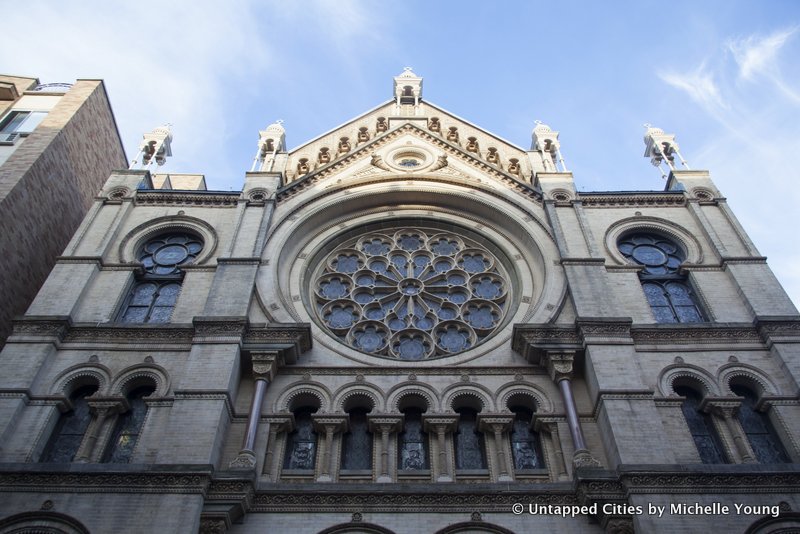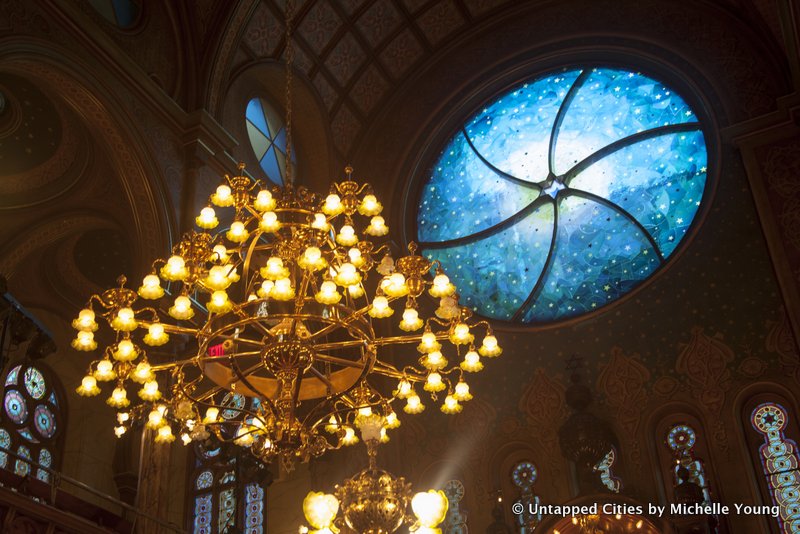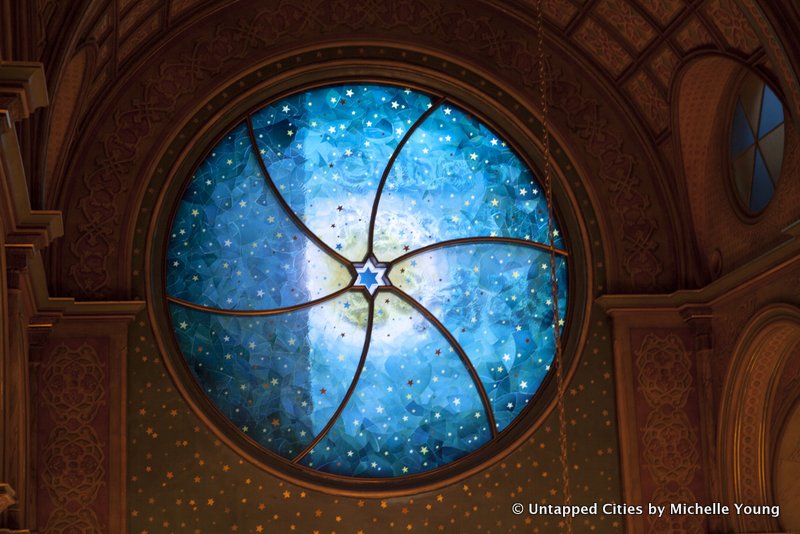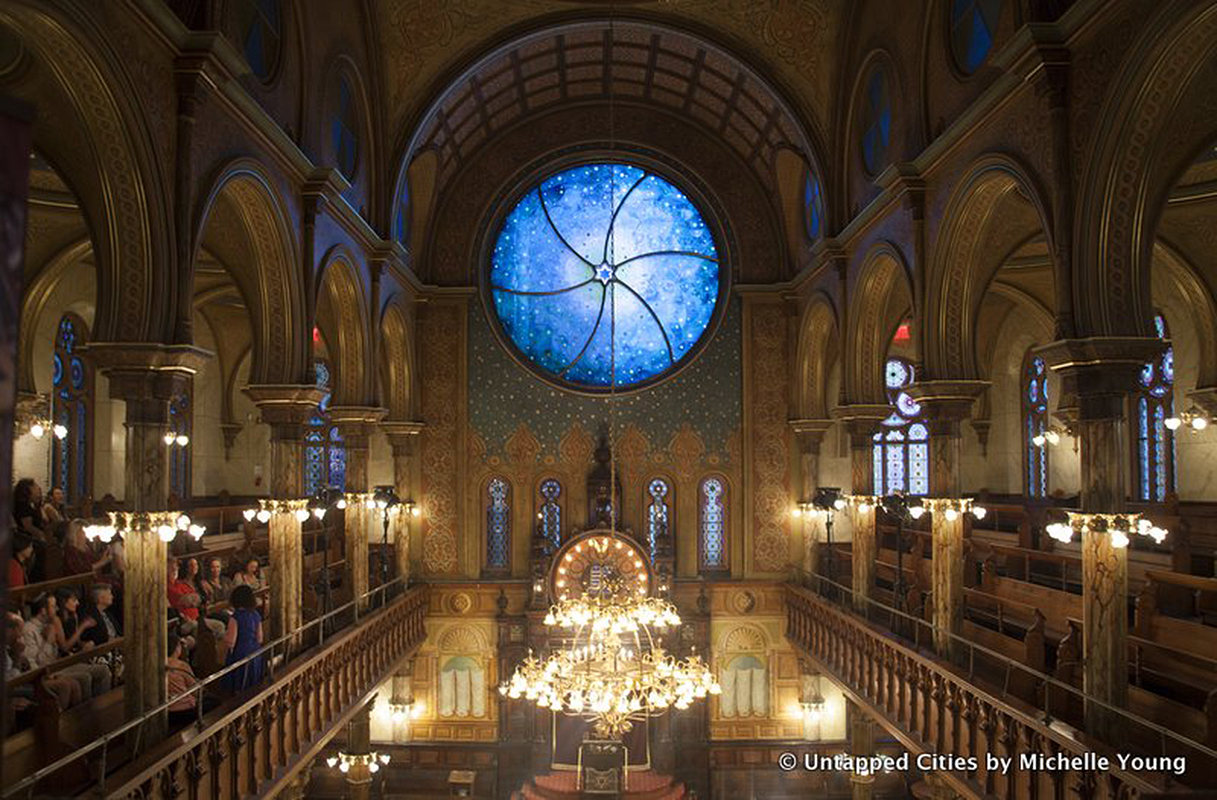The stunning architecture of the Eldridge Street Synagogue is difficult to ignore—even for disinterested New Yorkers passing by on their daily commutes. Located between Division and Canal Streets, the Lower East Side institution and National Historic Landmark is embellished with elaborate fixtures, from its collection of 68 stained-glass windows to its mock-Turkish motifs and carved wooden doors. Walk inside the sanctuary and you’ll find yourself suddenly steeped in over 120 years of history while standing below 50-foot ceilings.
On our upcoming after-hours (and behind-the-scenes) tour of the synagogue, we’ll delve into the unique history of the building, beginning with its opening on September 4, 1887. Reputed to be the first house of worship built by Eastern European Jews in the United States, the synagogue once served as a cultural hub for hundreds of immigrants from Russia and Poland—particularly during its heyday in the late 19th century.
Secrets of the Eldridge Street Synagogue After Hours Tour

By the 1920s-40s, however, membership began to decline due to immigration quotas, which limited the amount of new arrivals that could enter the country. Coupled with the devastating effects of the Great Depression, the synagogue eventually fell into disrepair: the main sanctuary was sealed off in the mid-1950s; pigeons began to reside in the balconies and dust soon collected on the benches.
To restore the building to its original grandeur, the non-sectarian Eldridge Street Project was founded in 1986 to head a 20-year, $20 million restoration project. This eventually gave way to the synagogue’s reopening as the Museum at Eldridge Street in December 2007, which also coincided with its 120th anniversary.
Today, one of synagogue’s most noted fixtures is a direct result of this restoration effort: a 6,000-pound, stained-glass rose window, created by artist Kiki Smith and architect Deborah Gans, now sits on its eastern wall, overlooking the sanctuary.

Installed in 2010, the stunning piece is comprised of 1,200 pieces of acid-etched Lamberts antique flash glass, adhered with silicone and set in a steel frame. It takes the place of four columns of glass blocks, which were installed in the 1940s, when the wooden frame of the original Eastern stained-glass rose window began to weaken. (To this day, no one knows what it looked like aside from the fact that it was circular.)
With no documents outlining the design of the original rose window, the board of directors at the museum opted for a new center piece, which would compliment the already existing architecture of the synagogue. It currently stands as the only 21st century addition to the 19th century synagogue.
“It was more about doing justice to the architecture— the whole feeling of the place and its history—rather than simulating the past,” architect Deborah Gans tells Untapped Cities.
“We wanted to take the painted wall, illustrating the sky and the night light, and extend it to the real opening to the sky. The window is almost like one of the [round sky-light] domes [in the ceiling], but turned on its side.”
The actual design of the window features a traditional six-pointed Star of David at its center, as well as a collection of five-pointed stars spread out across a blue background. The use of both shapes serves as a nod to the historical and cultural contributions brought to America by generations of immigrants.
“There are five-point stars because that’s the star of the American flag and this is as much an American monument as it is a temple,” explains Gans, in quoting Kiki Smith.
While stained glass is traditionally held together by lead, the new window utilizes silicon and laminate technologies. This ultimately allows a “different sense of light” to seep through the cracks where lines of lead would have originally been placed. This adhesion technique was first implemented in Germany, but executed and refined by Gil Studio for the Eastern rose window project (the first time the technique has been used in the United States).
As you can imagine, hoisting and installing the window was no easy feat. Its 4,000-pound solid steel frame (as opposed to hollow metal tubes or a wooden frame) was designed to combat the tortional, or twisting, force that each spiral arm is subjected to when the wind blows against it. This is especially important as questions still linger about whether the original window had been blown out in a hurricane.

Despite such advanced technologies and the contemporary, celestial design, the window somehow seamlessly fits into the existing context of the synagogue. “It was a set piece, within a rigid structure, so it was a meditation on stuff that was already there. We live in a state of distraction—especially in offices; you’re going to work and your nose is down on a desk. When you do religious buildings, you want to get rid of distraction and make a place of contemplation, and that’s what these sacred places do,” says Gans.
To this day, the Eldridge Street Synagogue continues to stand as a “tangible monument” to religious freedom and economic opportunity. This is true more so than ever, as the historic sanctuary reaffirms its commitment to welcoming people of all faiths, cultures and backgrounds, especially in response to the recent order on immigration.
To that end, we leave you with a light-hearted fun fact, which Gans jokingly describes as “a little bit made up:”
“It’s an Orthodox synagogue and originally the women had to sit upstairs when they had service there (they still do). So the place where you actually see the window straight on—the kind of ‘privileged point of view,’ to some regard, is from the women’s balcony.”
Join us for a special tour of the syangogue’s secrets After Hours with the Museum at Eldridge Street this month:






